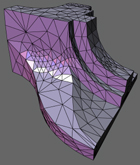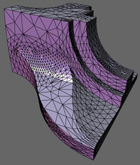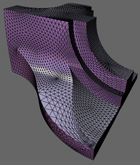


|
Multiresolution representations (see "What is Multiresolution?") have proven
to be extraordinarily powerful tools in meeting these
challenges. One class of these multiresolution representations is
based on radical
generalizations of classical wavelet constructions to the settings
encountered in computer graphics. A key element of this strategy is
the use of "Subdivision" and the "Lifting Scheme" to build wavelets in
the so called "2nd Generation" setting. Another, more recent class of
multiresolution representations is based on sequential simplification
procedures. We are engaged in exploring both approaches for computer
graphics simulation, modeling, and rendering.
Key features that we look for in these new approaches are
- Solid mathematical foundations: Smoothness, approximation
properties, and error analyses are required to make performance
guarantees.
- Robust numerical algorithms: As model sizes grow, issues
of numerical robustness become paramount and algorithms need to
deal with them gracefully.
- Generality and uniformity: The basic algorithms should be
applicable in the arbitrary topology setting and be uniform
across topologies, constraints, and scale.
- Scalability: The asymptotic complexity of the basic
computational kernels should ideally be linear in time and space.
- Simple data structures and algorithms: The basic kernels
should be simple so that specializations and enhancements do not
lead to an explosion of software complexity.
- Conciseness of representation and control: To keep large
models manageable representation must be concise and support control
"knobs" at different scales for effective control.
Multiresolution representations meet these challenges and we are
using them in a wide variety of projects.
|














